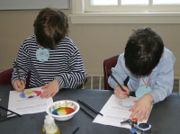User:Dmccabe/usual suspects
Contents
These are the most common editorial comments I enter in student's wikis
Formatting citations
To insure that a reader can reliably track down the specific book or article you intended, it is useful to provide the following information:
- Author(s) (last name followed by first initials; secondary authors: initials followed by last name); year; Book title or article title; publisher (for books) or Periodical title (for articles); volume and page numbers (both for articles)
Formatted examples:
- Brown, M.W. and C. Hurd. 1947. Goodnight Moon. Harper.
- Bentley, W.A. 1905. Studies of raindrops and raindrop phenomena. Monthly weather review. 32. 450
Once changes have been made, delete the following text: {{citations}}
Formatting figures
Any photograph, map, diagram, or handout that is embedded in your wiki counts as a figure. Tables should be handled differently.
Adding numbered captions to your figures can simplify your writing. You can refer a reader to a picture as simply as this: (Fig 1). No need to say see below or to the right of this text, particularly when the figure may move depending on the window size in which the page is viewed. So, I suggest captions like this: Figure 1. Enough detail following the figure number to orient the reader to the image. Figure captions do not work well in the Rich Text editor, so it may be worth turning that off to edit captions. The following image and caption was added to this page using this syntax:[[Image:RainbowHypothesis.jpg|Figure 1: Students generating hypotheses|thumb]]
Once changes have been made, you should delete the text ''{{Figures}}''from your page.
Using Galleries
I notice that you have several images on your page. It may be useful to organize them in a gallery. The format is quite simple:
The following captioned gallery was added to this page using this syntax:
<gallery caption="Data set 1;Valentine's Day snow storm 2007, South Burlington Vermont">
Image:315Small Snow.jpg|Figure 1. Snow accumulation at 3:15 during a snowstorm on Feb 14 2007 in South Burlington Vermont USA; click to view closer
Image:345 smallSnow.jpg|Figure 2. Snow accumulation at 3:45; click to view closer.
Image:415 smallSnow.jpg|Figure 3. Snow accumulation at 4:15; click to view closer.
</gallery>
- Data set 1;Valentine's Day snow storm 2007, South Burlington Vermont
Once changes have been made, you should delete the text ''{{Gallery}}''from your page.
Spelling
Your page contains spelling errors. To improve it, please spell check. If you use Firefox, it contains a spell checker. Alternatively, edit the entire page, copy and paste the content into a word processing document, fix the spelling (being careful not to change any formats in the document, and then paste it back into the wiki. Don't forget to save your changes! Once changes have been made, you should delete the text ''{{Spell}}''from your page.
Formatting links
There are a few ways to create links to external web sites in the wiki.
Descriptive option for use in text
The best type of link for most situations includes a description of the linked site. This description appears as the title of the link e.g. Useful Web Site. To create a link like this just type a link and the description, separated by a space and enclosed in single square brackets: [http://www.exelearning.org Useful Web Site]. This will create a link to the Useful Web Site that appears like this: Useful Web Site and should be used in conjunction with the full citation in literature cited.
Footnote format
Enclosing the link in single square brackets without providing a description: [http://www.exelearning.org] ...will display the link as a number in brackets, like this: [1]. This format looks like a footnote and it should be used in conjunction with numbered full citations in literature cited.
For your citations section
Type in the full URL for the link: http://www.exelearning.org The wiki treats this text as a link like this: http://www.exe.learning.org and will display full web address. Use this format in your citations section so that users can work from a printout if needs be; avoid using this format in the main text of your lesson. This material adapted from here Once changes have been made, you should delete the text ''{{Links}}''from your page.
Brand names
Please keep in mind that this is an international resource. So, by all means list the product brands that you used along with the registered trademark symbol (which you may cut and paste from here), but also include a generic description of the product. Product names should be capitalized. Examples:
- Dixie® cups (4 oz waxed paper cups)
- Karo® syrup (clear corn syrup)
Non brand-name local terms like soda, pop, or minerals can be replaced with a more global terms like carbonated beverage or soft drink and the use of the registered trade mark symbol (®) is not needed. Once changes have been made, you should delete the text ''{{Brands}}''from your page.
Metric system
Please use the metric system for all measures and use the appropriate symbol in the correct case based on the Système International d'Unités (SI units). Imperial (US or English) units should be placed in parentheses if they are important (pint jars for example). This is important for at least two reasons:
- The scientific community adopts the metric system and we should model that for children in science class
- This is an international resource and SI units are internationally recognized. Imperial units vary from place to place.
Example: We used 118ml (4 US fluid ounce) Dixie cups for our experiment.
A commercial unit conversion site
Once changes have been made, you should delete the text ''{{Metric}}''from your page.



